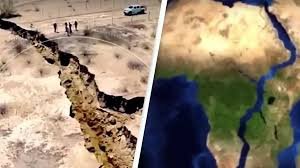Scientists have revealed that the African continent is on the brink of a major geological transformation, where East Africa is gradually separating from the rest of the continent, potentially leading to the formation of a new ocean.
The Earth’s crust is composed of several major tectonic plates that move slowly. The African and Somali plates are drifting apart at a rate of approximately 0.8 cm per year. Although this may seem insignificant, over millions of years, this gradual shift will split the African continent into two parts.
The most evident sign of this geological divide can be observed in Ethiopia’s Afar region, where a 60-kilometer-long and 10-meter-deep fissure has already formed. This crack is continuously expanding due to volcanic activity beneath the Earth’s surface.
In 2005, Ethiopia experienced more than 420 earthquakes, causing large cracks in the ground. According to scientists, a process that typically takes centuries to complete occurred within just a few days in this region.
If this process continues, East Africa will eventually become an island, completely separated from the African continent. As a result, a new ocean will emerge, dividing East Africa from the rest of the continent.
This transformation will drastically alter the ecosystem and geographical landscape, potentially forming new islands and coastal areas.
Such geological changes occur at an extremely slow pace, but scientists estimate that this process could be completed within a million years or even less.
As the cracks on the Earth’s surface expand, many areas could become uninhabitable due to increased earthquakes and volcanic activity.
Climate changes may also occur, as the formation of new sea routes will impact wind and ocean currents. The borders of African nations may shift as the land separation leads to the emergence of new islands.
It is a fact that the Earth is never static, and this new ocean in Africa is the latest example of its continuous evolution.
This astonishing geological process has the potential to permanently alter the world map. Scientists are closely monitoring this phenomenon to better understand how underground changes will shape the future of our planet.










